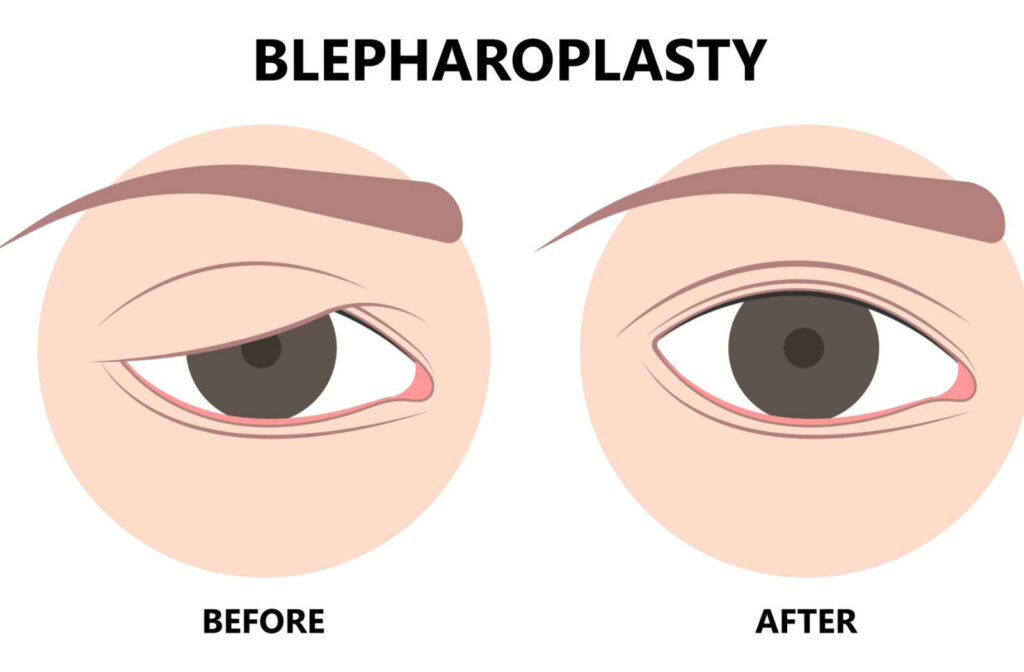Precision in Rejuvenation: The Art and Science Behind Blepharoplasty Benefits
Posted on: January 26, 2024
Blepharoplasty, commonly known as eyelid surgery, is a procedure that enhances the appearance of the eyes by removing excess skin and fat. This surgical technique not only offers cosmetic benefits but also improves vision for those with obstructive upper eyelids. With precision and care, blepharoplasty can rejuvenate facial aesthetics and contribute to a more youthful and alert look. As individuals seek solutions for aging or tired eyes, understanding this transformative option becomes essential.
Understanding the Blepharoplasty Procedure
Surgery Steps
The blepharoplasty procedure involves several key steps. First, a surgeon will consult with the patient to determine their needs and goals. They discuss potential risks and outcomes.
Next, before surgery begins, precise markings are made on the areas of the eyelids to indicate where corrections will be applied. This ensures accuracy during the procedure.
Anesthesia Options
Patients undergoing blepharoplasty have options for anesthesia. Local anesthesia with sedation is common for patient comfort. In some cases, general anesthesia may be used depending on individual circumstances or preferences.
A professional anesthesiologist usually administers and monitors sedation throughout surgery to ensure safety.
Facility Choices
Blepharoplasties can occur in various settings. Some surgeons perform this surgery in hospital operating rooms while others use accredited outpatient surgical facilities.
Choosing a reputable facility is crucial for safety and quality care during and after the blepharoplasty procedure.
Types of Blepharoplasty
There are different types of blepharoplasty tailored to address specific issues:
- Upper eyelid blepharoplasty focuses on removing excess skin that droops over the eye.
- Lower eyelid blepharoplasty targets puffiness or bags under eyes.
- A combined approach addresses both upper and lower lids simultaneously for a more comprehensive result.
Surgeons recommend which type suits each patient based on their unique facial structure and desired outcome.
Aesthetic Improvements with Eyelid Surgery
Under-Eye Enhancement
Blepharoplasty can significantly reduce under-eye bags. These changes result in a more rested and vibrant appearance. The procedure involves small incisions where excess fat, often causing puffiness, is removed.
Patients see a noticeable decrease in morning swelling. This benefit alone can make a dramatic difference to one’s face.
Youthful Contour
Eyelid surgery restores youthful contours around the eyes. Over time, eyelids may droop or become hollowed – known as periorbital hollows. Blepharoplasty addresses these issues by removing excess skin and possibly tightening underlying tissues.
The outcome is smoother eyelids that reflect light better, giving off a fresher look.
Symmetry Correction
Improving symmetry between both eyes is another goal of blepharoplasty. No face is perfectly symmetrical, but noticeable differences can be bothersome. By making precise adjustments to the orbital septum and surrounding structures, an oculoplastic surgeon enhances balance across the face.
This correction helps patients feel more confident about their overall appearance.
Functional Benefits of Correcting Droopy Eyelids
Vision Enhancement
After blepharoplasty, patients often experience improved peripheral vision. This is because the surgery removes or repositions tissue that may block sight. With less obstruction, individuals can see more to the sides without turning their heads.
These changes can make activities like driving safer. People might notice they react faster to things coming from the side. This improved reaction time can prevent accidents and increase overall safety.
Reduced Strain
Post-surgery, many find their eyelids feel lighter. The correction of droopy eyelids means muscles work less to lift them. Less effort leads to fewer headaches and a feeling of relief for many patients.
Activities such as reading become easier too. Before surgery, some struggle with keeping their eyes open for long periods due to strain; after surgery, this issue often disappears.
Skin Comfort
Blepharoplasty also addresses skin irritation caused by excess folds rubbing together. When these folds are reduced or eliminated:
- There’s less chance for moisture and bacteria buildup.
- Patients report decreased inflammation and discomfort.
- Daily routines like applying makeup become smoother and more comfortable.
Psychological Impact and Boosted Confidence
Improved Self-Esteem
Blepharoplasty can do more than just restore vision impaired by droopy eyelids. Many patients find a new sense of self after the procedure. The change in appearance often leads to an increase in self-esteem. They feel better about how they look.
This surgery removes the extra weight of sagging skin around the eyes. Patients report feeling lighter, both physically and emotionally. They no longer see a tired face in the mirror but one that reflects their inner vitality.
Social Benefits
The psychological benefits extend into social spheres as well. Individuals who have undergone blepharoplasty notice positive changes in their interactions with others. Their newfound confidence supports them in both personal and professional settings.
Testimonials from ASPS members reveal that patients experience support through their transformation journey, leading to enhanced social engagement post-surgery.
Vision Improvement and Quality of Life
Visual Field
Blepharoplasty, more than just a cosmetic procedure, can significantly enhance vision. Studies have shown that patients often experience improved results in visual field tests after surgery. This means that the area which a person can see while their eyes are fixed on a point has expanded.
Patients report being able to see more to the top and sides without tilting their head. This is crucial for activities where peripheral view matters, like driving or sports. The removal or repositioning of excess tissue allows for an unobstructed view.
Daily Activities
The benefits of blepharoplasty extend into everyday life. With better vision comes an increase in quality of life scores among patients. They find daily tasks such as reading and navigating easier post-surgery.
For many people, especially those at an advanced age, this improvement is transformative. It affects not only how they look but also how they interact with the world around them day by day. A clearer vision leads to greater independence and confidence in performing routine activities safely.
Preparing for Your Eyelid Surgery
Medical Evaluations
Before undergoing blepharoplasty, certain medical evaluations are essential. These tests ensure your safety and readiness for the procedure.
Your surgeon may request a comprehensive eye examination. This test checks for conditions like eyelid retraction or dry eyes, which could affect surgery outcomes. Sometimes, a vision test is also performed to assess any issues that might complicate recovery.
You might need blood tests as well. They help in evaluating your general health status before the operation.
Medication Guidance
It’s crucial to discuss all medications and supplements with your doctor prior to surgery. Some substances can increase bleeding risk and should be avoided.
Common items to avoid include:
- Aspirin
- Anti-inflammatory drugs
- Herbal supplements
Always inform your surgeon about any regular medication you take. They will advise on what you can continue or need to stop using before the procedure.
Fasting and Transportation
Fasting before eyelid surgery is typically required. Your surgical team will provide specific instructions on when to stop eating and drinking.
Arranging transport home after surgery is also vital since you won’t be able to drive yourself due to anesthesia effects or temporary vision impairment from swelling or dressings.

Post-surgery care planning is important too. Make sure someone can stay with you during the initial recovery period at home. Remember these guidelines carefully as they play a key role in ensuring a smooth blepharoplasty experience and successful results following improved vision quality discussed earlier.
Postoperative Care and Long-Term Results
Recovery Timeline
After blepharoplasty, patients typically experience a recovery period. The first few days are crucial for healing. Patients may notice swelling and bruising around the eyes. Surgeons often schedule follow-up appointments to monitor progress.
In the initial week, rest is vital. Most patients can return to normal activities within ten days. However, complete healing can take several weeks.
Minimizing Swelling
Post-surgery care is essential to reduce complications. To minimize swelling and bruising:
- Keep your head elevated.
- Use cold compresses.
- Avoid strenuous activities.
These steps aid in a smoother recovery process.
Surgical Outcomes
Blepharoplasty offers rejuvenation around the eyes for years. Yet, outcomes vary among individuals due to factors like skin quality and lifestyle habits.
Patients should have realistic expectations regarding results longevity. While some effects are immediate, full benefits become apparent after months as swelling subsides completely.
Risks and Complications to Consider
Common Side Effects
After blepharoplasty, patients often experience some side effects. One might notice temporary blurred vision. This usually clears up without treatment. Another common side effect is dry eyes.
These effects are typically short-lived. However, they can be bothersome for a while.
Serious Risks
While most people recover without issues, there are serious risks too. In rare cases, one could have an infection or significant bleeding after surgery.
It’s crucial to discuss these with your surgeon beforehand.
Summary
Blepharoplasty, a transformative eyelid surgery, offers a multitude of benefits ranging from aesthetic enhancements to significant functional improvements. It not only alters one’s appearance but also contributes to better vision and quality of life. Patients experience renewed self-confidence and psychological well-being post-surgery. While preparing for the procedure and adhering to postoperative care are crucial for optimal outcomes, understanding the potential risks is equally important. The collective insights from the procedure’s preparation to its long-term results underscore blepharoplasty’s role in addressing both physical and emotional concerns.
As you consider the comprehensive advantages of blepharoplasty, remember that a thorough consultation with a qualified plastic surgeon is vital. They can provide personalized advice and ensure you are well-informed about all aspects of the surgery. If you’re contemplating this life-enhancing procedure, take the next step towards improved well-being by scheduling an appointment with a specialist today.
Frequently Asked Questions
What is blepharoplasty?
Blepharoplasty is a surgical procedure that corrects sagging or drooping eyelids by removing excess skin, muscle, and sometimes fat.
Can blepharoplasty improve vision?
Yes, by removing the obstruction of droopy eyelids, blepharoplasty can enhance peripheral vision and overall quality of life.
What are the aesthetic benefits of eyelid surgery?
Eyelid surgery offers aesthetic improvements such as a more youthful appearance and reduction in bagginess from lower eyelids.
How does correcting droopy eyelids benefit functionally?
Functionally, it reduces eye strain and fatigue while improving field of view obstructed by sagging upper lids.
Will I gain confidence after blepharoplasty?
Many patients report increased self-esteem post-surgery due to enhanced facial aesthetics and improved visual function.
What should I expect when preparing for eyelid surgery?
Expect consultations regarding your medical history, physical eye examinations, and discussions about expectations and potential outcomes.
What are common risks associated with blepharoplasty?
Common risks include infection, dry eyes, difficulty closing eyes completely, temporary blurred vision or double vision.





